Managing stakeholder expectations is an important skill for a project manager to deliver a project successfully. When stakeholder’s expectations are clear, it is easier to align goals, communicate, and keep the project on track.
However, managing these expectations can be challenging as people have different priorities, interests, and levels of understanding.
In this article, we will understand how to effectively manage stakeholder expectations, keep everyone satisfied, and deliver successful outcomes.
What are stakeholder expectations?
Stakeholder expectations are the needs, interests and outcomes that stakeholders anticipate from a project or initiative. These expectations can include timelines, deliverables, deadlines, communication frequency, return on investment, or overall project success. The expectations of stakeholders are shaped by each stakeholder’s role, interests, and level of involvement.
From transparent communication preferences and quality expectations to simply sticking to project timelines and budgets, expectations are a whole mix of several parameters. Be it project-specific requirements, strategic objectives, or relational expectations, a project can thrive in a healthy environment only when the stakeholders’ concerns are carefully looked into and addressed.
For example:
- A project team would want clear directions, understanding, and tools to tick off the task list.
- Investors, on the other hand, would expect an impressive and increased return on their investment.
Why managing stakeholder expectations is important?
Managing stakeholder expectations reduces project delays, avoids miscommunication, builds trust, reduces conflicts, and enhances client satisfaction. When expectations are clearly defined and managed, stakeholders are more likely to stay engaged, support project decisions, and remain satisfied with outcomes.
Here is why managing stakeholder expectations is important.
1. Prevents delays – Clear expectations help avoid scope creep and unnecessary changes, keeping the project on track.
2. Avoids miscommunication – Clear expectations prevent misunderstandings and ensure everyone is on the same page.
3. Improves project success – Projects run more smoothly when expectations align with goals and are more likely to succeed.
4. Builds trust – Transparency and consistent updates foster trust between stakeholders and project teams.
5. Reduces conflicts – Properly managed expectations help minimize conflicts between stakeholders with different priorities.
6. Enhances satisfaction – Meeting or exceeding stakeholder expectations leads to higher satisfaction and long-term support.
7. Promotes long-term partnerships – Addressing shareholders’ expectations increases trust, strengthens relationships, promotes long-term partnerships, and opens avenues for future investments.
8. Boosts morale and productivity – Meeting team members’ expectations boosts morale and productivity, increases ownership, and creates a positive work environment.
9 Tips to manage stakeholder expectations
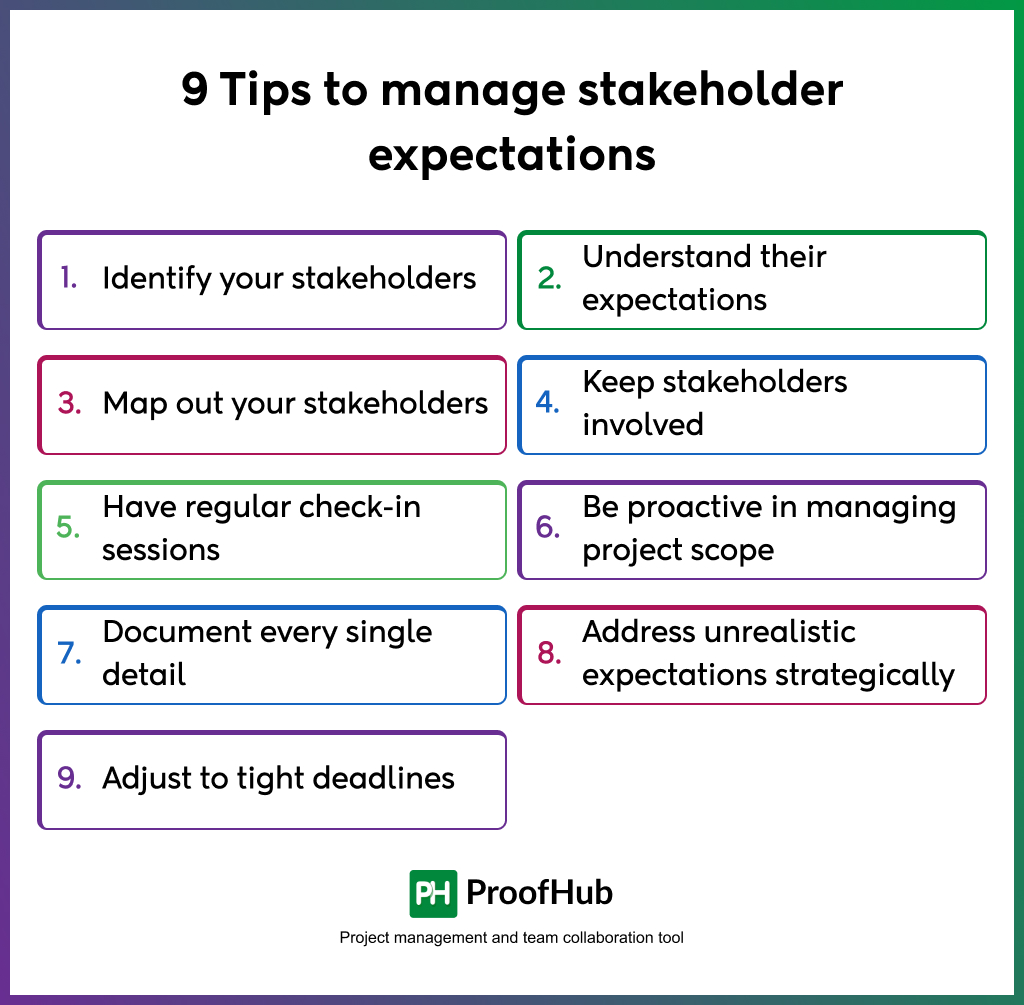
Managing stakeholder expectations is not a one-go practice. It is an ongoing and ever-evolving process to avoid project failure.
Here are some practical steps that you can take to keep up your hold on enhancing project stakeholder satisfaction.
1. Identify your stakeholders
First thing first, compile a list of all your stakeholders in a document.
While some stakeholders may be obvious to pinpoint, you might fail to notice not-so-obvious ones. The process is necessary because you can only manage expectations effectively when you know who you need to cater to.
Once that is done, move forward with outlining stakeholders’ interests and their influence or impact. Regardless of how small their role is in the decision-making process and the project lifecycle, everyone should be on your radar. Investing time in stakeholder analysis yields compounding interest in your efforts to manage their expectations.
2. Understand their expectations and needs
Now that you’ve compiled a thorough list of stakeholders, the next step is to get the gist of stakeholders’ needs and expectations. Sit down with them, engage in discussions, or call out for a meeting with all of them (if possible) to get a crystal clear idea of their precise expectations. Determine the factors they consider non-negotiable and the specific needs they want to fulfill.
However, don’t consider your task complete just yet. This is where the main challenge lies. There is a huge difference between leadership expectations and those of team members. Navigating through these conflicting definitions of success can be demanding. In this scenario, it is imperative to delve deeper into the motivations behind the certain outcome.
3. Map out your stakeholders
Once you have a complete understanding of your stakeholders and their expectations, your immediate objective should be to map out them on the power/interest grid. This grid divides stakeholders into four distinct quadrants:
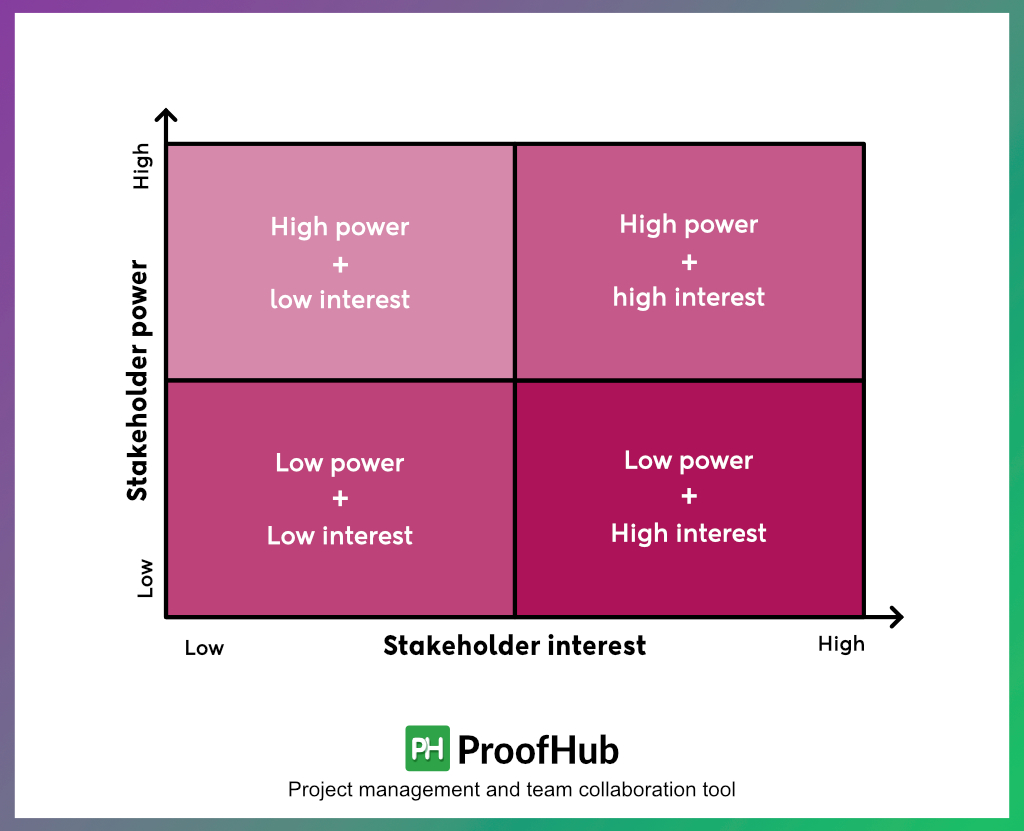
- High power – high interest: Pay more attention to these stakeholders and manage them closely
- High power – low interest: Ensure considering the satisfaction of these stakeholders
- Low power – High interest: Keep these stakeholders informed all the time despite their limited influence
- Low power – Low interest: Monitor these stakeholders but do not devote much efforts
Depending on the various stakeholders’ segmentation categories, you can get a better understanding of how you should deal with them. Stakeholder mapping is more of a statement analysis you make based on the following parameters:
- Interest
- Impact
- Influence/Power
4. Keep stakeholders involved and informed
As a project manager, it becomes your core responsibility to keep everyone in the loop and on the same ground. Avoid vague communication, instead provide clear facts that reflect the project’s health accurately. Ensure clear management and documentation of all your project objectives and progress for enhanced transparency.
ProofHub, for instance, offers a centralized platform for managing tasks, communication, and documents, keeping all stakeholders informed and engaged throughout the project lifecycle.
Depending on stakeholders’ needs, you should pass on the updates accordingly. For instance, you need to constantly feed in the details to team members for them to stay updated on project updates. Whereas, investors prefer concise summaries, that too occasionally. Because they usually have a lot to deal with and cannot dedicate a major chunk of their time to understanding the nitty-gritty of the project.
5. Have regular check-in sessions
Throughout the project lifecycle, you should uphold open and transparent communication channels with stakeholders. The practice enables you to evaluate performance assessment and gauge stakeholder sentiment. Analyze their opinions on the project progression, any impending issues, or any change in their perspectives.
Once you have a clear understanding of your stakeholders’ perceptions, you can fine-tune your approach accordingly for timely intervention. This helps your stakeholders remain informed and engaged, while your project management plan stays on track.
6. Be proactive in managing project scope
Speaking of scope, any potential change can sneak its way into your project plan and impact the outcome. This can result in costly project delays and a surge in misunderstandings and dissatisfaction among stakeholders.
To save yourself from this overwhelming tide of unexpectedness, draft a project scope document with proactive measures when setting the baseline. Assess the changes that you can easily incorporate into your plan and outline those that may challenge you to cope. Also, do not forget to keep stakeholders in the know of possible adjustments for smoother project execution.
7. Document every single detail
You are only human, and no computer. Even profound details can slip from your mind. And you may get into some serious trouble. To avoid these destructive and expensive mistakes, maintain a central log of all the issues, information, and changes.
Whether it is the slightest alteration in total quality management criteria or changes in stakeholder behaviors and expectations, record everything. Not just that, document every stakeholder engagement activity to leave no room for surprises and prevent undesirable reactions.
8. Address unrealistic expectations strategically
There may come many instances where you may encounter stakeholders bringing countless unrealistic expectations to a project. And these expectations often stem from their unreasonable perspectives and assumptions. For instance, stakeholders may underestimate the time and effort required to complete a task and propose challenging timelines.
To resolve this pattern, educate your stakeholders about project constraints, budget limitations, available resources, project scope, and tight timelines. Back up your reasoning with clear statistics and factual numbers. Also, by showcasing the trade-offs involved, you can present a clear picture of the potential consequences. The key to staying firm on the realistic ground is to collaborate transparently on project realities and be rational about the constraints.
9. Adjust to tight deadlines
Ensuring project success during tight deadlines is incredibly challenging. Balancing the need to keep everyone on the same page while driving others to get things done within the set timeframe is like fighting a battle against the water you are swimming in.
However, prioritizing and adapting are the key skills for surviving during the compact time limits. By delivering the optimal project outcomes, you can showcase your ability to perform under pressure. And that requires you to refine your strategy and adjust your approach to meet the deadlines effectively. Lastly, do not overlook the importance of keeping stakeholders informed about the critical features and project developments.
How to understand stakeholder needs and interests?
Before you can manage expectations, you need to understand what your stakeholders want. Different stakeholders may have different priorities, and understanding those is the foundation for effective expectation management.
1. Conducting stakeholder interviews: Stakeholder interviews are a great way to gather insights into their needs, concerns, and goals. By asking open-ended questions, you can identify what’s most important to them and shape your project accordingly.
2. Gathering feedback through surveys: Surveys can provide an anonymous way for stakeholders to express their expectations, allowing for a more in-depth understanding of what matters to the group as a whole. This can be especially useful when dealing with larger groups of stakeholders.
3. Categorize stakeholders: By grouping stakeholders based on their level of interest and influence, you can prioritize those who need the most attention. This ensures you focus on the key players while managing expectations effectively for all groups.
4. Observe industry trends: Keeping an eye on market and industry trends allows you to anticipate shifts in stakeholder expectations. This proactive approach ensures you are prepared to address their future needs effectively.
How to measure stakeholder satisfaction throughout a project?
Stakeholder satisfaction can be measured through regular feedback, engagement metrics, and progress alignment with expectations. It is a key indicator of project success and should be monitored consistently throughout the project lifecycle. Here’s how to measure it in a structured way:
1. Stakeholder surveys and feedback forms: Create short surveys at regular intervals to gather direct input from stakeholders. Ask questions including, communication effectiveness, expectations, confidence in project progress, satisfaction with involvement level etc.
2. One-on-one interviews or check-ins: Hold regular conversations with key stakeholders to understand their concerns and expectations. It can uncover hidden issues that surveys may miss and help build trust through direct engagement.
3. Engagement and participation levels: Track how often stakeholders attend meetings, respond, and contribute feedback. High engagement often indicates satisfaction, while declining involvement could be a red flag.
4. Track expectation vs delivery: Compare initial stakeholder expectations with what has been delivered so far. Use project milestones, deliverables, and scope changes to evaluate if aligned with stakeholders expectations.
5. Review project after key milestones: After each major phase, conduct reviews to reflect on what went well, what could be improved, and whether stakeholders feel satisfied with the direction of the project.
Manage all your stakeholders with a project management tool
ProofHub is one of the best project management and team collaboration software that elevates your stakeholder management practices with its comprehensive features.
The platform offers some premium features at flat-rate pricing that enhance your ability to align stakeholder expectations with the final project outcome.
1. Centralized collaboration
ProofHub creates a shared space for your stakeholders and their expectations together. With its built-in chat and discussions, everyone can coordinate in real time without diving into the sea of scattered emails.
Not just that, it also centralizes all your project-related information like files, tasks, and discussions.
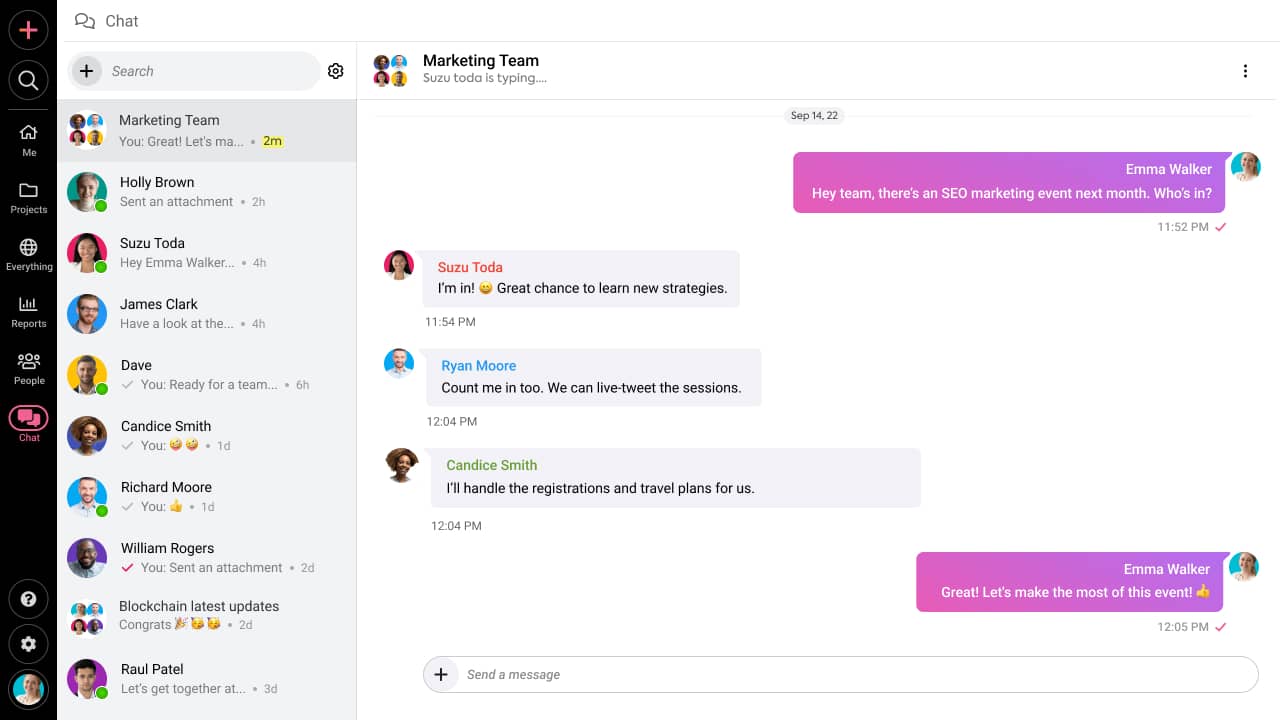
2. Set clear goals and expectations
With ProofHub, you can establish clear timelines and deliverables, and eliminate the room for unrealistic expectations.
By assigning specific roles and defining clear responsibilities based on expertise and contribution expected, you can increase accountability in your project objectives and create a more responsible environment.
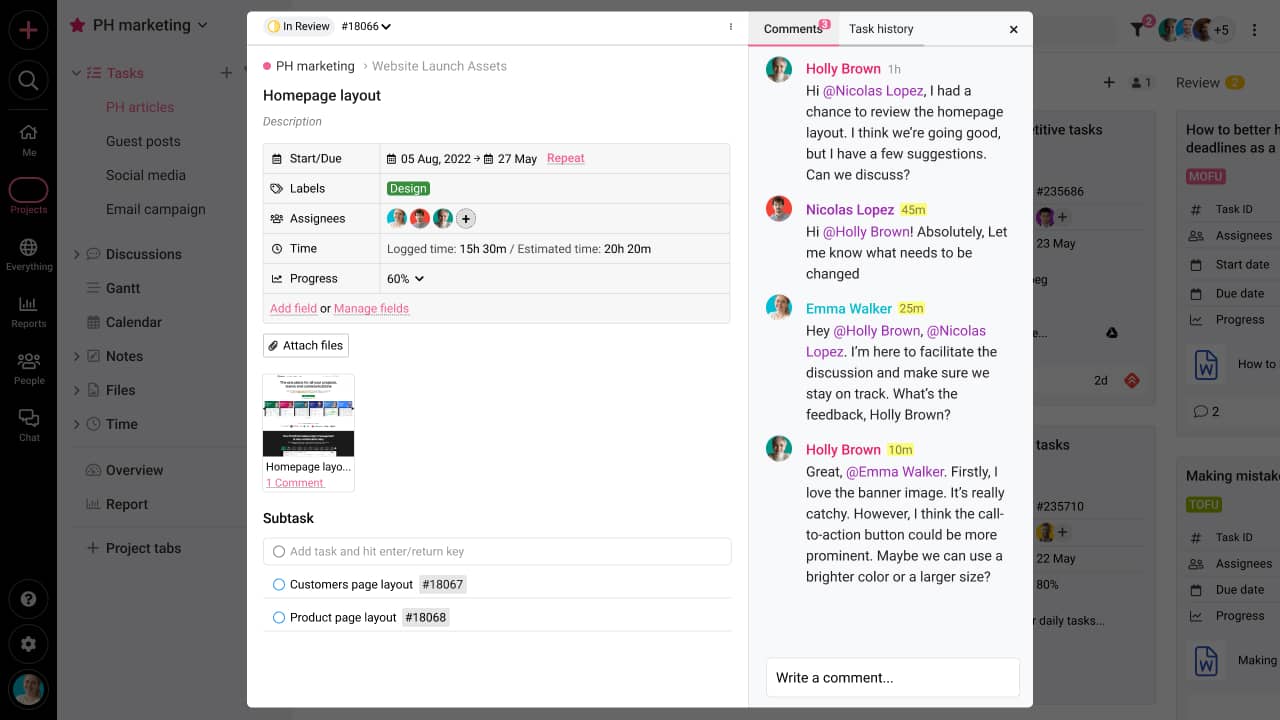
3. Real-time reporting and visibility
ProofHub’s real-time and custom reporting provide stakeholders supreme visibility into the project’s progress. Using this data-driven information, managing expectations becomes possible in a realistic manner.
Be it task progression or resource utilization, its comprehensive dashboard and reports are suitable for providing real-time insights into project performance.
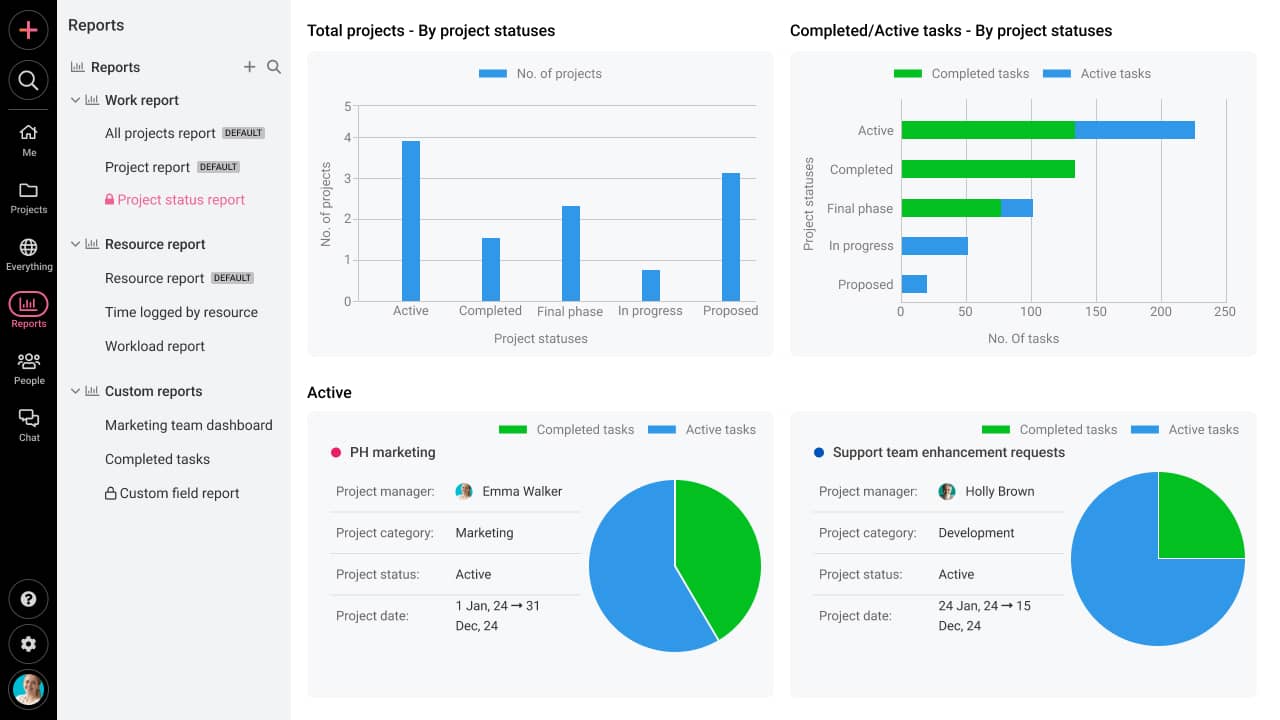
4. Stay on top of incoming requests
ProofHub offers comprehensive work request forms to handle and capture incoming stakeholder requests. These forms guarantee that you stay fully aware of the stakeholder expectations to avoid misunderstandings later on.
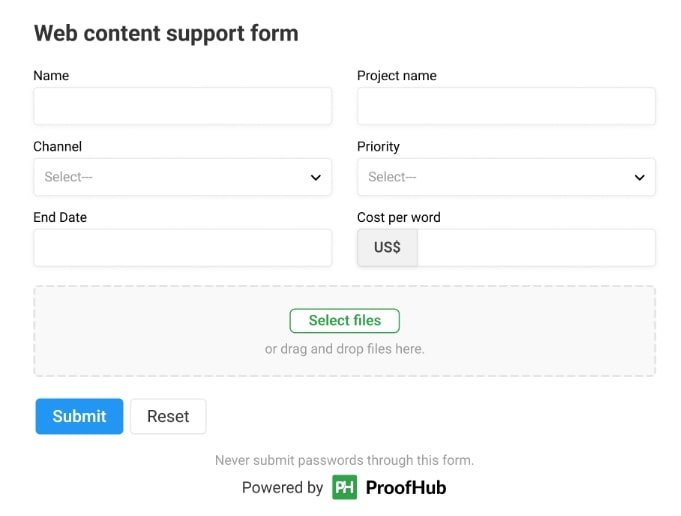
Examples of stakeholders expectations
1. Client’s expectations example: A client expects the project to be completed within 3 months and under budget. Expected outcome – timely delivery, high-quality outcomes, regular updates, and value for money.
2. Project Manager’s expectation example: A project manager expects stakeholders to provide timely approvals to avoid delays. Expected outcome – Clear communication, stakeholder support, and resource availability.
3. Team Member’s expectation example: Developers expect complete requirements and no major scope changes mid-project. Expected outcome – clear goals, realistic deadlines, and access to necessary tools or information.
Conclusion
Stakeholders are the critical components of a project. As a project manager, it falls on you to strive to work towards meeting their expectations. By understanding what your stakeholders want and aligning those expectations with realistic project goals, you can ensure the success of your project and maintain strong relationships with all involved parties.
When it comes to getting things done while prioritizing stakeholders’ needs, ProofHub can be a great platform.
Ready to take your stakeholder management to the next level? Try ProofHub for free and experience the difference! No credit card is required. Cancel anytime.
Frequently asked questions
How do you understand stakeholder needs and expectations?
The best method to understand stakeholder needs and expectations is to identify every stakeholder involved in the project, followed by a thorough analysis of their interests and influence. When done, the next step is to have an inclusive discussion about their expectations.
Whose is responsible for managing stakeholder expectations?
It is the prime responsibility of a project manager to manage stakeholder expectations throughout the project. Despite the entire weight of responsibility on the project manager’s shoulders, the process is a collaborative effort where everyone plays a role in ensuring successful expectation alignment.

